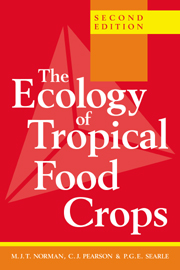3 - Tropical crop/soil relations
Published online by Cambridge University Press: 05 June 2012
Summary
Broad features of soils in the tropics
Important applications for the study of tropical soils include the relation of soils to the productivity of farming and forestry systems, and the fate of areas under native vegetation which are being converted to new forms of farming and forestry. For instance, recent estimates indicate that over the period 1981–90 the rate of deforestation has increased from 11.3 to 17 m ha yr−1, about 8.5 million ha being deforested annually in the moist tropical zone (FAO, 1990). Some reports suggest that deforestation rates in South America increased nearly two-fold between 1980 and 1989 (Houghton, 1990). The decline in soil fertility after clearing can be rapid, particularly in high-rainfall areas on soils susceptible to erosion, and if cleared in inappropriate ways (Lai, 1981a, 1984). The properties and management of soils cleared of natural vegetation in the tropics need to be fully comprehended if fertility is to be conserved in the transition to new forms of land use. There is an urgent need to develop sustainable systems in deforested and cropped areas and to reduce the deforesting of further areas; clearing rainforests is considered a significant cause of global warming (EPA, 1990) climate change (Shukla, Nobre & Sellers, 1990) and loss of biological diversity.
Figure 3.1 provides globally collated estimates of the deterioration of soils through deforestation and inappropriate soil and crop management.
- Type
- Chapter
- Information
- The Ecology of Tropical Food Crops , pp. 46 - 84Publisher: Cambridge University PressPrint publication year: 1995



